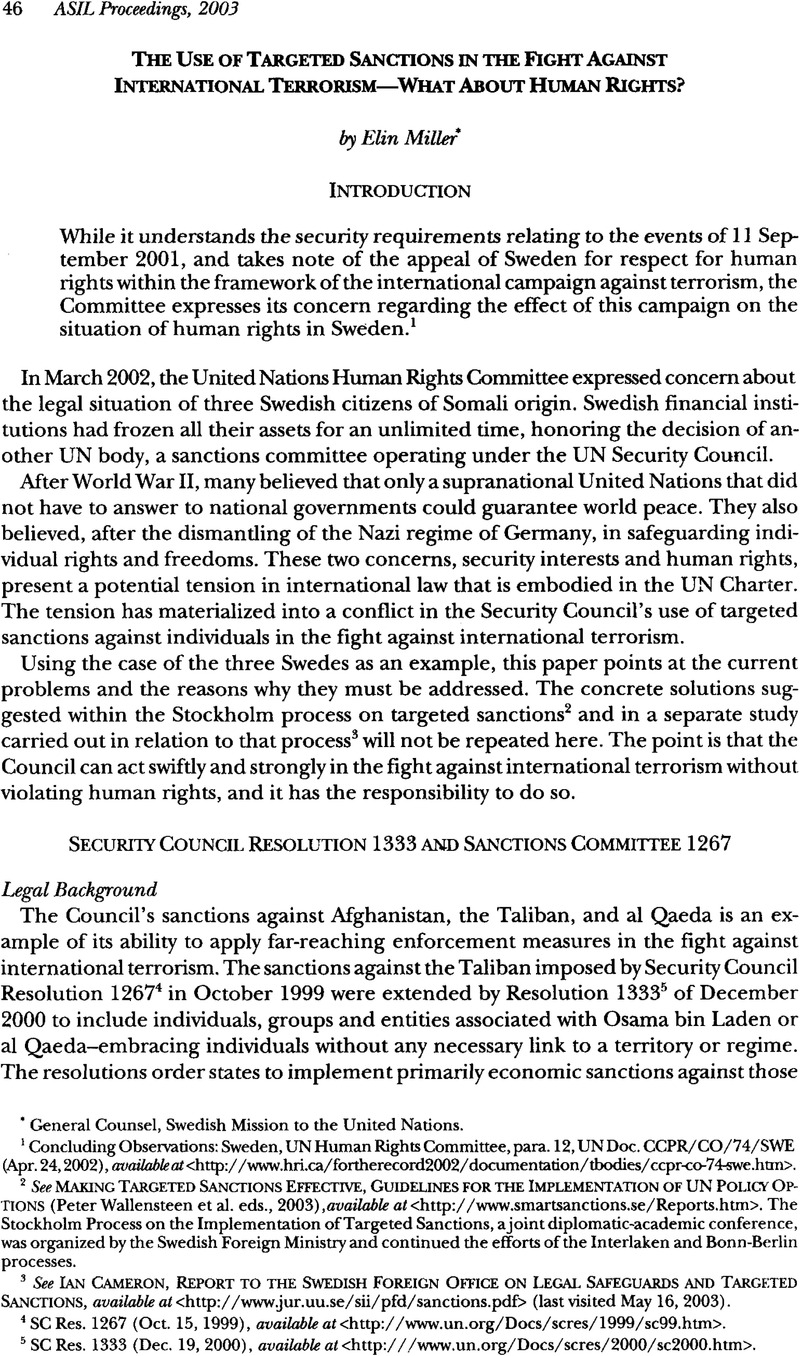No CrossRef data available.
Article contents
The Use of Targeted Sanctions in the Fight Against International Terrorism—What About Human Rights?
Published online by Cambridge University Press: 28 February 2017
Abstract

- Type
- An Imperial Security Council? Implementing Security Council Resolutions 1373 and 1390
- Information
- Copyright
- Copyright © American Society of International Law 2003
References
1 Concluding Observations: Sweden, UN Human Rights Committee, para. 12, UN Doc. CCPR/CO/74/SWE (Apr. 24, 2002), avilable at <http://www.hri.ca/formerecord2002/docmnentation/tbodies/ccpr-co-74-swe.htm>.
2 See Making Targeted Sanctions Effective, Guidelines for the Implementation of UN Policy Options (Peter Wallensteen et al. eds., 2003), available at <http://www.smartsanctions.se/Reports.htm>. The Stockholm Process on the Implementation of Targeted Sanctions, a joint diplomatic-academic conference, was organized by the Swedish Foreign Ministry and continued the efforts of the Interlaken and Bonn-Berlin processes.
3 See Ian Cameron, Report to the Swedish Foreign office on Legal Safeguards and Targeted Sanctions, available at <http://www.jur.uu.se/sii/pfd/sanctions.pdf> (last visited May 16, 2003).
4 SC Res. 1267 (Oct. 15, 1999), available at <http://www.un.org/Docs/scres/1999/sc99.htm>.
5 SC Res. 1333 (Dec. 19, 2000), available at <http:///www.un.org/Docs/scres/2000/sc2000.htm>.
6 The list also contains entities but their aspects are not covered by this paper.
7 SC Res. 1390 (Jan. 16, 2002), available at <www.un.org/Docs/scres/2002/sc2002.htm>.
8 SC Res. 1452 (Dec. 20, 2002), available at <http://www.un.org/Docs/scres/2002/sx2002.htm>.
9 SC Res. 1455 (Jan. 17, 2003), available at <http:///www.un.org/Docs/scres/2003/sc2003.htm>.
10 A new, consolidated version of the list issued on February 24, 2003 is published at <http://www.un.org/Docs/sc/committees/1267/1267ListEng.htm>.
11 See European Council Reg. 467/2001 (Mar. 6, 2001), replaced by European Council Reg. 881/2002 (May 27, 2002), available at <http://www.eurunion.org/partner/EUUSTerror/EUandAfganistan.htm>.
12 For a discussion of the validity of European Union implementation of the sanctions regime, see Andersson, Torbjörn et al., EU Blacklisting: The Renaissance of Imperial Power, but on a Global Scale, 14 Eur. Bus. L. Rev. 111-41 (2003)Google Scholar.
13 European Commission Reg. 2199/2001 (Nov. 12, 2001), available at <http://www.eurunion.org/partner/EUUSTerror/EUandAfganistan.htm>.
14 Resolution 1333 does not require that a listed person have committed a crime and he may not be aware that his action may have contributed to financing terrorism. Further, a measure under Article 41 is not necessarily a sanction in its traditional meaning, i.e., deployed against a lawbreaker, but may be applied when it is considered conducive to maintaining international peace and justice. It then has an administrative, preventive character.
15 In Resolution 1390, the Security Council requested that the 1267 Committee “update regularly. . . on the basis of relevant information provided by Member States and regional organizations” and “promulgate such guidelines and criteria as may be necessary to facilitate the implementation of the measures.” SC Res. 1390 (Jan. 28, 2002), para. 5(a), (d), available from <http://www.un.org/Docs/scres/2002/sc202.htm>.
16 Case T-306/01, Abdirisak Aden v. Commission (Dec. 10, 2002), available from <http://europa.eu.int>.
17 See European Council Common Position on Combating Terorism, 2001/930/CFSP (Dec. 27, 2001); European Council Common Position on the Application of Specific Measures to Combat Terrorism, 2001/931/CFSP (Dec. 27,2002); European Council Reg. 2580/2001 (Dec. 12, 2001). Relevant provisions state that the list
shall be drawn up on the basis of precise information or material... which indicates that a decision has been taken by a competent authority... whether it concerns the instigation of investigations or prosecution ... or condemnation___‘[C]ompetent authority’ shall mean a judicial authority, or... an equivalent competent authority in that area. . . . The Council shall work to ensure that names . . . have sufficient particulars appended to permit effective identification ..., thus facilitating the exculpation of those bearing the same or similar names.... [T]he names . . . and entities on the list. . . shall be reviewed at regular intervals ... to ensure that there are grounds for keeping them on die list.
EC Common Posidon, 2001/931/CFSP, paras. 4-6 ((Dec. 27, 2001), avilable at <http://www.deltur.cec.eu.int/english/SpecificMeasuresCombTerrorm.pdf>.
18 It has been suggested that the time limit of the no-objection procedure, 48 hours, be extended to give members of the committee more time to make independent assessments of names put forward. However, the more time between when the listings become known and when the measures are enforced, the more likely it is that accounts are found empty. A well-designed review mechanism would provide a legal safeguard without rendering the sanctions regime less efficient.
19 Supra note 17, para. 6.
20 Cameron has suggested that a review mechanism consist of an arbitral body where the judges appointed enjoy the trust of both the listed individual and die proposing state. See Cameron, supra note 3, at 47.
21 See SC Res. 1390, supra note 10.
22 See Guidelines of the Committee for die Conduct of its Work, UN Security Council Committee Established Pursuant to Resolution 1267 (1999) (Nov. 7, 2002), available at <http://www.un.org/Docs/sc/committees/1267/1267_guidelines.pdf>.
23 Id., para. 5(a).
24 Id., para. 5(a)-(c).
25 Id., para. 7(a)-(d). If the designating state is a member of the committee, the chances of success must be considered slim.
26 One could also argue that the members of the Security Council and the 1267 Committee are bound individually, in their national capacities, to abide by their human rights commitments.
27 Although these provisions do not state an express legal obligation to honor human rights, they impose at least a moral duty on states to do their best in good faith to respect and promote human rights.
28 For a thorough analysis of human rights obligations in the Swedish case, see Cameron, supra note 3.
29 See id. at 32.
30 There was general agreement early in the like of the United Nations that effective protection of human rights through or under the auspices of the United Nations would strengthen the authority of the organization; see 1 Oppenheim’s International Law 991 (Roberts Jennings & Arthur Watts eds., 9th ed. 1996).


